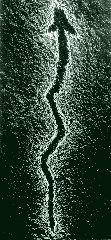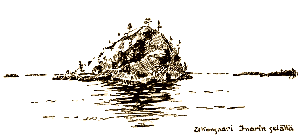|
The Snake and Zig-Zag Motifs in
Finnish Rock Paintings and Saami Drums The main problem with the interpretation of Finnish rock paintings is the significance of shamanism. After surveying the most shamanistic motifs in the rock art and Saami drums E. Autio concludes that there are other possibilities besides shamanism for construckting an interpretation of the rock paintings (the votive offer, mythological beings, etc.). |
 |
Relative from Across the River of
Blood: Lapp Folk Tales About Totem Reindeer. VI
Enn Ernits
The sixth part is concerned with Meandash as a cultural hero (4.2) and Meandash being chased by thunder-god (4.3.1).

The story of the cultural hero (story 23.; written by V.Charnolusky) reveals that Meandash has given the Lapp a bow and taught him to hunt. In the story Meandash imparts of teaching (taboos) to the archer how to hunt so that there would be enough wild animals.
Five pieces of writing refer to thunder-god. Two of them (story 24 and 25) have been published by V. Nemirovich-Dantchenko whereby the latter differs only by its additional ending. The third tale (story 26) based on the previous ones and information gathered from Kola has been written down by V.Charnolusky. The rest of the texts (story 27 and 28) deal with traditions associated with thunder-god; they might be based on the myth, still, in their present form they serve rather as an additional material of the three first variations.
The three eschatological variations under discussion are multi-layered. The genuine concepts formed under the influence of a powerful natural phenomenon have been appended most obviously to the Scandinavian ragnarök and the Iranian story of Mithra. The Christian period, on the other hand, has brought in biblical scenes about the doomsday. Furthermore, the collectors-authors have formed the material into a literary text. A number of folk traditions, including that of the Lapps, have developed a concept of a rainbow made of thunder-bow, the idea originates in nature itself. It also gives rise to the battle-motif. A rainbow is the bow of the thunder-god, as well as its aurochs. How this ox would be associated with the sun-god is another question - the connection seems loose.
Sacrificial rites of the Votyak
people on the other side of the Kama river
Tatyana Minniyakhmetova
A small group of heathen Votyaks living on the other side of the Kama river (in the Northwest Bashkiria and in the Kuyeda region of the Perm oblast) still hold on to the ancient heathen religion which has been influenced by the developing world religions. The current article observes the sacrificial customs in the religion of the Votyak on the other side of the Kama in the context of ritual behaviour. In some cases it also views the traditional customs of other Votyak ethnic and ethnographic groups.
The sacrifice had, and still has, an important role in nearly every Votyak ritual, whether it be collective or daily, random or special. Collective sacrifice was performed, and still is, on certain holidays of popular calendar, on family and kindred festivities. Special collective sacrifice was performed in case of bigger emergencies in the village or the region. Every sacrifice irrespective of the type of the ritual had its organisers: sacrificial priests and their assistants. Every ritual procedure had a specific site and structure. The family sacrifice had an significant role as well, it was performed at the beginning and finishing major works and at important family events. Individual sacrificial rites which in some way influence the whole surrounding world were performed, if necessity called, any time and anywhere.
The offerings of the Votyaks on the other side of the Kama could be divided in two groups: food and other objects. Almost all the types of the offerings described by the earlier researchers have been preserved until today. Still, the sacrifice of horses and cattle is performed very rarely, also the custom of sacrificing wild fowl and silver coins is almost obsolete. The former offerings are replaced by inexpensive and easily accessible objects.
Three ancient Peruvian cultural
horizons - three different religions?
Tarmo Kulmar
The influence of the Chavin religion to the religion of Tiahuanaco is of principle nature. The Paracas religion seems to have a smaller impact, still, its significance can not be underestimated. Thus it is rational to view these three as the sc kindred religions, i.e. the Peruvian religion of the middle horizon is merely a further elaboration of the religions of the earlier horizons and they are the two layers of the same pre-Incan religion.
The Tiahuanaco religion has influenced the Inca religion in a number of ways and although they seem to be important at first the influence is somewhat secondary, despite of the fact that the Inca culture and that of Tiahuanaco were kindred cultures. In the course of founding the Empire of Tahuantinsuyu a totally new religion emerged on the basis of the pre-Incan religion. Thus, the religion of the Incas is radically different - it is the religion of a totalitarian state.
Consequently, the answer is the following: three cultural horizons - two religions.
The Development of the Definition
of Folklore in Estonia
by Tiiu Jaago
The 1990s was a tumultuous decade in the Estonian society - the crisis in Estonian folkloristic studies was reflected in the following phenomena: theory lagged behind practice, the research priorities hitherto (Kalevala-song, folklore's poetics) were substituted for newer ones (folk religion, heritage group folklore), modern folklore arose as equal next to the folklore of the past. Among other things the new situation demanded the modernisation of the definition of folklore. Besides folkloristic practice the definition is also shaped by local scientific tradition (vertical cultural axis) and currently prevalent international cultural contacts (horizontal cultural axis).
In the 19th century, during the period of beginning and early development Estonian folklore has been influenced mainly by folklore in German language, at the turn of the century it was also influenced by Finnish folklore - the dialogue with Finland has lasted till now; during the Soviet period after WW2 prevailed research trends characteristic to Russian folklore, by 1990s it had cast aside Russian folkloristic trends paving the way for introducing European and, more significantly, American folkloristic trends and emerging them into Estonian folklore.
In Estonia the science of folklore can be considered as a sub-discipline of philology and all the periods mentioned above are characterised by the prevalence of text-centred research trends and linguistic research methods in folklore. Parallelly, the Estonian folklore has been interested in the historical aspect of oral traditions. 1930s and 1990s are characterised by a growing concern towards historical-ethnological research. The emergence of modern folklore into Estonian folklore has shifted the research preference from text to presentation. Reforms in science demanded also the modernisation of the definition of folklore.
For the introductory course in folklore science at the University of Tartu I have formulated the notion as following: «Folk poetry or folklore is a syncretical intellectual heritage of a culturally homogeneous group. It holds knowledge, experience and aesthetics. Folklore is developed, preserved and spread via communication process and it is characterised by constant change.
Historical Strata of the Estonian
Folk Music. II
Ingrid Rüütel
The article consists of 62 examples of the traditional music of Estonia.
|
A Old Song Songs by Heno Sarv and Priit
Pedajas. |
Heno Sarv - 670 kb .mp3 |
Priit Pedajas - 650 kb .mp3 |
|
Wiscous Dongues in Jokes
Regarding Different Gender Jokes
The famous German folklorist discusses gender jokes. Comments by Reet Hiiemäe |
|
![[Img]](pics/vh7.jpg)
St John's Day in
Setomaa
Heiki Valk
Field diaries of Heiki Valk.
![[Girl]](pics/bl1.jpg)